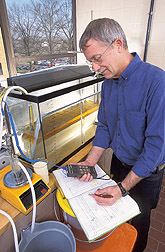This page has been archived and is being provided for reference purposes only. The page is no longer being updated, and therefore, links on the page may be invalid.
|
Read the magazine story to find out more. |
Corn Protein Could Reduce Ethanol Production CostsBy Jim CoreApril 15, 2002 Corn’s not just for dinner. Most of the crop is used in livestock feed, and it is also processed into many food and industrial products, including starch, sweeteners, corn oil, and beverage and industrial alcohols. Corn’s starch is also converted to sugar and then fermented into fuel ethanol by brewer’s yeast. Ethanol is increasingly being combined with gasoline to lift octane levels and make a cleaner-burning fuel. But production of ethanol from corn has created a surplus of corn byproducts that are becoming more difficult to sell. One such byproduct is zein, a valuable protein that’s used mostly as an edible, water-resistant coating for nuts, confectionary products and pharmaceutical tablets. Zein sells for about $10 per pound. But in the dry-milling ethanol process, zein stays behind in the dried distillers grain (DDG) that’s used in livestock feed. With the rapid expansion of ethanol production, the DDG supply is expected to far exceed demand. Engineers at the Agricultural Research Service’s Eastern Regional Research Center in Wyndmoor, Pa., realized that if they could find a way to extract zein at a lower cost, it would become more attractive as a commodity, increasing potential profits from non- starch corn byproducts. The ARS researchers engineered and built an ethanol pilot plant to find ways to boost economic returns of commercial corn-fermentation plants where ethanol is created. Then they developed a system that uses ethanol as the solvent to extract zein from dry- milled corn. This method could represent significant savings because the necessary solvent would already be available since ethanol is the primary product of the corn- fermentation plants. After the corn is fermented into ethanol, part of the ethanol is used for the zein extraction, then recycled back into the system. This method gives corn-ethanol plant owners an option of producing a value-added coproduct--the zein--that would provide more revenue and reduce the overall cost of the ethanol production. Efforts are now under way to determine the maximum concentration of zein that can be directly extracted from corn. A more detailed story on this research is available in the April issue of Agricultural Research magazine. ARS is the chief scientific research agency of the U.S. Department of Agriculture. |

